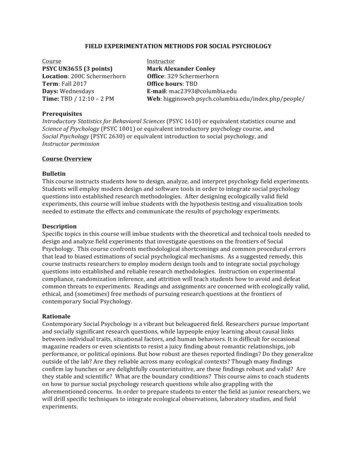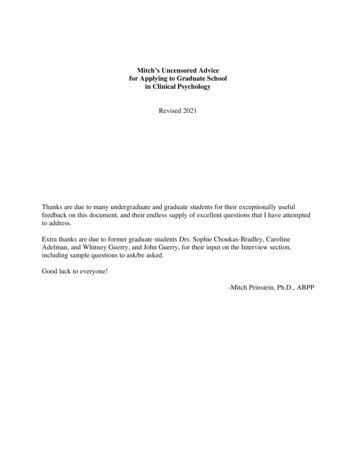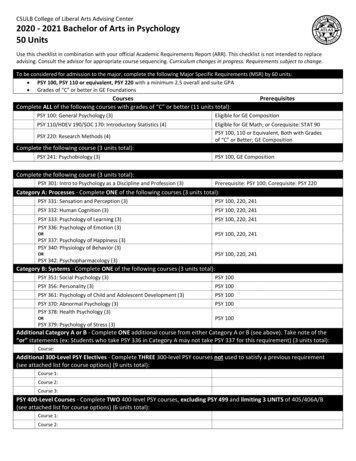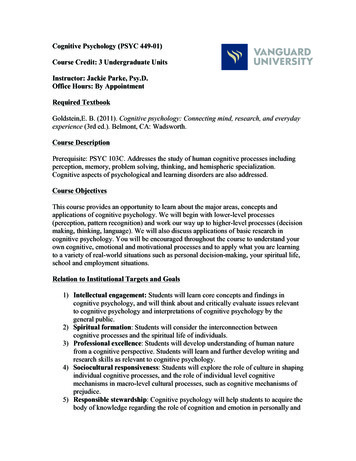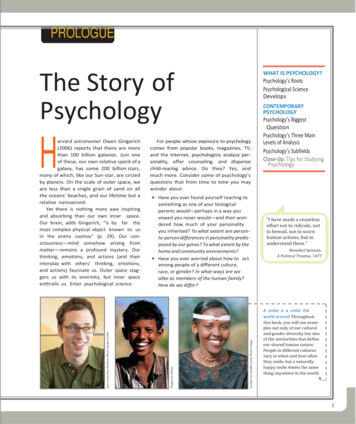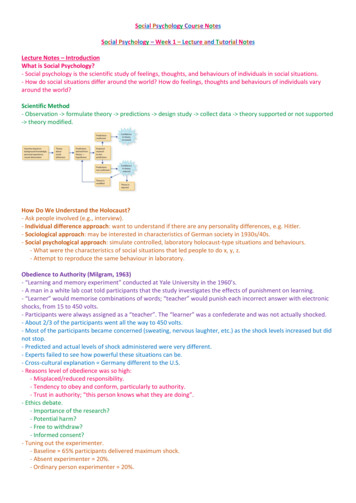
Transcription
Social Psychology Course NotesSocial Psychology – Week 1 – Lecture and Tutorial NotesLecture Notes – IntroductionWhat is Social Psychology?- Social psychology is the scientific study of feelings, thoughts, and behaviours of individuals in social situations.- How do social situations differ around the world? How do feelings, thoughts and behaviours of individuals varyaround the world?Scientific Method- Observation - formulate theory - predictions - design study - collect data - theory supported or not supported- theory modified.How Do We Understand the Holocaust?- Ask people involved (e.g., interview).- Individual difference approach: want to understand if there are any personality differences, e.g. Hitler.- Sociological approach: may be interested in characteristics of German society in 1930s/40s.- Social psychological approach: simulate controlled, laboratory holocaust-type situations and behaviours.- What were the characteristics of social situations that led people to do x, y, z.- Attempt to reproduce the same behaviour in laboratory.Obedience to Authority (Milgram, 1963)- “Learning and memory experiment” conducted at Yale University in the 1960’s.- A man in a white lab coat told participants that the study investigates the effects of punishment on learning.- “Learner” would memorise combinations of words; “teacher” would punish each incorrect answer with electronicshocks, from 15 to 450 volts.- Participants were always assigned as a “teacher”. The “learner” was a confederate and was not actually shocked.- About 2/3 of the participants went all the way to 450 volts.- Most of the participants became concerned (sweating, nervous laughter, etc.) as the shock levels increased but didnot stop.- Predicted and actual levels of shock administered were very different.- Experts failed to see how powerful these situations can be.- Cross-cultural explanation Germany different to the U.S.- Reasons level of obedience was so high:- Misplaced/reduced responsibility.- Tendency to obey and conform, particularly to authority.- Trust in authority; “this person knows what they are doing”.- Ethics debate.- Importance of the research?- Potential harm?- Free to withdraw?- Informed consent?- Tuning out the experimenter.- Baseline 65% participants delivered maximum shock.- Absent experimenter 20%.- Ordinary person experimenter 20%.
- Contradictory experimenters close to 0%.- Tuning in the learner.- Remote feedback 65% participants delivered maximum shock.- Voice feedback 62%.- Proximity 40%.- Touch proximity 30%.Factors of Obedience- Immediacy: how close or obvious the victim or the authority figure was to the participant.- When the victim was visible in the same room, 40% obeyed to the limit.- Obedience was reduced to 20% when the experimenter was absent from the room and relayed directions bytelephone.- Gradual escalation of behaviour if first shock was 450v participants much less likely to start; once people say ‘yes’it is much harder to pull out or say no.- Release from responsibility; the experimenter assumed the responsibility.Obedience Across Cultures- Milgram’s experiment has been replicated in Italy, Germany, Australia, Britain, Jordan, Spain, Austria, and theNetherlands. Complete obedience ranged from over 90% in Spain and the Netherlands, through over 80% in Italy,Germany and Austria, to a low of 40% among Australian men and only 16% among Australian women.Social Psychology Around the WorldEvolutionary Perspective- Human minds are rooted in physical and psychological predispositions that helped our ancestors survive andreproduce.- Certain commonalities in psychological processes around the world reflecting survival issues that were common toour ancestors.- If everyone, all over the world, is behaving in a similar way then it must be human nature or innate.Cross-Cultural Perspective- Human behaviours are rooted in influences from culture, which is a collection of beliefs, values, rules, and customsthat are shared among a group of people.Individualistic Culture- Cultures in which people tend to think of themselves as distinct social entities, tied to each other by voluntarybonds of affection and organisational membership but essentially separate from other people and having attributesthat exist in the absence of any connection to others; e.g. U.S., Canada, Australia.- Be unique; express self; realise internal attributes; promote own goals; be direct, ‘say what’s on your mind’.Collectivist Culture- Cultures in which people tend to think of themselves as part of a collective, inextricably tied to others in theirgroup, and in which they have relatively little personal control over their lives but do not necessarily want or needthese things; e.g. Asia, South America.- Belong, fit in; occupy one’s proper place; engage in appropriate action; promote others’ goals; be indirect, ‘readothers’ mind’.- Does level of education attained influence music preference? Yes.- Rock music individualist themes.- Higher education rock music tendency for individualism.- Country music collectivist themes.- Lower education country music tendency for collectivism.- Similarities evolutionary perspective.- Differences cross-cultural perspective.
Social Psychology – Week 1 – Reading NotesChapter 1 – Introducing Social Psychology – What is Social Psychology?- Social psychology has been defined as ‘the scientific investigation of how the thoughts, feelings and behaviours ofindividuals are influenced by the actual, imagined or implied presence of others’.- Social psychologists are interested in explaining human behaviour and generally do not study animals. Somegeneral principles of social psychology may be applicable to animals, and research on animals may provide evidencefor processes that generalise to people (e.g. social facilitation). Furthermore, certain principles of social behaviourmay be general enough to apply to humans and, for instance, other primates. As a rule, however, socialpsychologists believe that the study of animals does not take us very far in explaining human social behaviour, unlesswe are interested in its evolutionary origins.- Social psychologists study behaviour (what people actually do that can be objectively measured) becausebehaviour can be observed and measured. However, behaviour refers not only to obvious motor activities but alsoto more subtle actions such as a raised eyebrow, a quizzical smile or how we dress, and, critically important inhuman behaviour, what we say and what we write. In this sense, behaviour is publicly verifiable. However, themeaning attached to behaviour is a matter of theoretical perspective, cultural background or personalinterpretation.- Social psychologists are interested not only in behaviour, but also in feelings, thoughts, beliefs, attitudes, intentionsand goals. These are not directly observable but can, with varying degrees of confidence, be inferred frombehaviour; and to a varying extent may influence or even determine behaviour. The relationship between theseunobservable processes and overt behaviour is in itself a focus of research; for example, in research on attitudebehaviour correspondence and research on prejudice and discrimination. Unobservable processes are also thepsychological dimension of behaviour, as they occur within the human brain. However, social psychologists almostalways go one step beyond relating social behaviour to underlying psychological processes – they almost alwaysrelate psychological aspects of behaviour to more fundamental cognitive processes and structures in the humanmind and sometimes to neuro-chemical processes in the brain.- What makes social psychology social is that it deals with how people are affected by other people who arephysically present (e.g. an audience) or who are imagined to be present (e.g. anticipating performing in front of anaudience), or even whose presence is implied. This last influence is more complex and addresses the fundamentallysocial nature of our experiences as humans. For instance, we tend to think with words; words derive from languageand communication; and language and communication would not exist without social interaction. Thought, which isan internalised and private activity that can occur when we are alone, is thus clearly based on implied presence. Asanother example of implied presence, consider that most of us do not litter, even if no one is watching and even ifthere is no possibility of ever being caught. This is because people, through the agency of society, have constructed apowerful social convention or norm that proscribes such behaviour. Such a norm implies the presence of otherpeople and ‘determines’ behaviour even in their absence.- Social psychology is a science because it uses the scientific method to construct and test theories. Social psychologyhas concepts such as dissonance, attitude, categorisation and identity to explain social psychological phenomena.The scientific method dictates that no theory is ‘true’ simply because it is logical and seems to make sense. On thecontrary, the validity of a theory is based on its correspondence with fact. Social psychologists construct theoriesfrom data and/or previous theories and then conduct empirical research, in which data are collected to test thetheory.Social Psychology and Its Close Neighbours- Social psychology is poised at the crossroads of a number of related disciplines and subdisciplines. It is asubdiscipline of general psychology and is therefore concerned with explaining human behaviour in terms ofprocesses that occur within the human mind. It differs from individual psychology in that it explains social behaviour.For example, a general psychologist might be interested in perceptual processes that are responsible for peopleoverestimating the size of coins. However, a social psychologist might focus on the fact that coins have value (a caseof implied presence, because the value of something generally depends on what others think), and that perceivedvalue might influence the judgement of size. A great deal of social psychology is concerned with face-to-faceinteraction between individuals or among members of groups, whereas general psychology focuses on people’sreactions to stimuli that do not have to be social.- The boundary between individual and social psychology is approached from both sides. For instance, havingdeveloped a comprehensive and highly influential theory of the individual human mind, Sigmund Freud set out todevelop a social psychology. Freudian, or psychodynamic, notions have left an enduring mark on social psychology,
in particular in the explanation of prejudice. Since the late 1970s, social psychology has been strongly influenced bycognitive psychology, in an attempt to employ its methods (e.g. reaction time) and its concepts (e.g. memory) toexplain a wide range of social behaviours. In fact, what is called social cognition is the dominant approach incontemporary social psychology, and it surfaces in almost all areas of the discipline. In recent years, the study ofbrain biochemistry and neuroscience has also influenced social psychology.- Social psychology also has links with sociology and social anthropology, mostly in studying groups, social andcultural norms, social representations, and language and intergroup behaviour. In general, sociology focuses on howgroups, organisations, social categories and societies are organised, how they function and how they change. Theunit of analysis (i.e. the focus of research and theory) is the group as a whole rather than the individual people whomake up the group. Sociology is a social science whereas social psychology is a behavioural science – a disciplinarydifference with far-reaching consequences for how one studies and explains human behaviour.- Social anthropology is much like sociology but historically has focused on ‘exotic’ societies. Social psychology dealswith many of the same phenomena but seeks to explain how individual human interaction and human cognitioninfluence ‘culture’ and, in turn, are influenced or constructed by culture. The unit of analysis is the individual personwithin the group. In reality, some forms of sociology (e.g. microsociology, psychological sociology, sociologicalpsychology) are closely related to social psychology.- Just as the boundary between social and individual psychology has been approached from both sides, so has theboundary between social psychology and sociology. From the sociological side, for example, Karl Marx’s theory ofcultural history and social change has been extended to incorporate a consideration of the role of individualpsychology. From the social psychological side, intergroup perspectives on group and individual behaviour draw onsociological variables and concepts. Contemporary social psychology abuts sociolinguistics and the study of languageand communication, and even literary criticism. It overlaps with economics, where behavioural economists haverecently ‘discovered’ that economic behaviour is not rational, because people are influenced by other people –actual, imagined or implied. Social psychology also draws on and is influenced by applied research in many areas,such as sports psychology, health psychology and organisational psychology.- Social psychology’s location at the intersection of different disciplines is part of its intellectual and practical appeal.However, it is also a cause of debate about what precisely constitutes social psychology as a distinct scientificdiscipline. If we lean too far towards individual cognitive processes, then perhaps we are pursuing individualpsychology or cognitive psychology. If we lean too far towards the role of language, then perhaps we are beingscholars of language and communication. If we overemphasise the role of social structure in intergroup relations,then perhaps we are being sociologists. The issue of exactly what constitutes social psychology provides animportant and ongoing metatheoretical debate (i.e. a debate about what sorts of theories are appropriate for socialpsychology), which forms the background to the business of social psychology.Topics of Social Psychology- One way to define social psychology is in terms of what social psychologists study. Social psychologists study anenormous range of topics, including conformity, persuasion, power, influence, obedience, prejudice, prejudicereduction, discrimination, stereotyping, bargaining, sexism and racism, small groups, social categories, intergrouprelations, crowd behaviour, social conflict and harmony, social change, overcrowding, stress, the physicalenvironment, decision making, the jury, leadership, communication, language, speech, attitudes, impressionformation, impression management, self-presentation, identity, the self, culture, emotion, attraction, friendship, thefamily, love, romance, sex, violence, aggression, altruism and prosocial behaviour (acts that are valued positively bysociety).- One problem with defining social psychology solely in terms of its topics is that this does not properly differentiateit from other disciplines. For example, ‘intergroup relations’ is a focus not only of social psychologists but also ofpolitical scientists and sociologists. The family is studied notonly by social psychologists but also by clinical psychologists.What makes social psychology distinct is a combination of whatit studies, how it studies it and what level of explanation issought.Chapter 1 – Introducing Social Psychology – MethodologicalIssuesScientific Method- Social psychology employs the scientific method to study socialbehaviour. Science is a method for studying nature, and it is the
method – not the people who use it, the things they study, the facts they discover or the explanations they propose– that distinguishes science from other approaches to knowledge. In this respect, the main difference between socialpsychology and, say, physics is that the former studies human social behaviour, while the others study non-organicphenomena.- Science involves the formulation of hypotheses (predictions) on the basis of prior knowledge, speculation andcasual or systematic observation. Hypotheses are formally stated predictions about what factor or factors may causesomething to occur; they are stated in such a way that they can be tested empirically to see if they are true. Forexample, we might hypothesise that ballet dancers perform better in front of an audience than when dancing alone.This hypothesis can be tested empirically by assessing their performance alone and in front of an audience. Strictlyspeaking, empirical tests can falsify hypotheses (causing the investigator to reject the hypothesis, revise it or test it insome other way) but not prove them. If a hypothesis is supported, confidence in its veracity increases and one maygenerate more finely tuned hypotheses. For example, if we find that ballet dancers do indeed perform better in frontof an audience, we might then hypothesise that this occurs only when the dancers are already well rehearsed; inscience-speak, we have hypothesised that the effect of the presence of an audience on performance is conditionalon (moderated by) the amount of prior rehearsal. An important feature of the scientific method is replication: itguards against the possibility that a finding is tied to the circumstances in which a test was conducted. It also guardsagainst fraud.- The alternative to science is dogma or rationalism, where understanding is based on authority: something is truebecause an authority says it is so. Valid knowledge is acquired by pure reason and grounded in faith: that is, bylearning well, and uncritically accepting and trusting, the pronouncements of authorities. Even though the scientificrevolution occurred in the 16th and 17th centuries, dogma and rationalism still exist as influential alternative pathsto knowledge.- As a science, social psychology has at its disposal an array of different methods for conducting empirical tests ofhypotheses. There are two broad types of method, experimental and non-experimental: each has its advantagesand its limitations. The choice of an appropriate method is determined by the nature of the hypothesis underinvestigation, the resources available for doing the research (e.g. time, money, research participants) and the ethicsof the method. Confidence in the validity of a hypothesis is enhanced if the hypothesis has been confirmed a numberof times by different research teams using different methods. Methodological pluralism helps to minimise thepossibility that the finding is an artefact of a particular method, and replication by different research teams helps toavoid confirmation bias – which occurs when researchers become so personally involved in their own theories thatthey lose objectivity in interpreting data.Experiments- An experiment is a hypothesis test in which something is done to see its effect on something else. For example, if Ihypothesise that my car greedily guzzles too much petrol because the tyres are under-inflated, then I can conduct anexperiment. I can note petrol consumption over an average week, then I can increase the tyre pressure and againnote petrol consumption over an average week. If consumption is reduced, then my hypothesis is supported. Casualexperimentation is one of the commonest and most important ways in which people learn about their world. It is anextremely powerful method because it allows us to identify the causes of events and thus gain control over ourdestiny.- Not surprisingly, systematic experimentation is the most important research method in science. Experimentationinvolves intervention in the form of manipulation of one or more independent variables, and then measurement ofthe effect of the treatment (manipulation) on one or more focal dependent variables. In the example above, theindependent variable is tyre inflation, which was manipulated to create two experimental conditions (lower versushigher pressure), and the dependent variable is petrol consumption, which was measured on refilling the tank at theend of the week. More generally, independent variables are dimensions that the researcher hypothesises will havean effect and that can be varied (e.g. tyre pressure in the present example). Dependent variables are dimensionsthat the researcher hypothesises will vary (petrol consumption) as a consequence of varying the independentvariable. Variation in the dependent variable is dependent on variation in the independent variable.- Social psychology is largely experimental, in that most social psychologists would prefer to test hypothesesexperimentally if at all possible, and much of what we know about social behaviour is based on experiments. Indeed,one of the most enduring and prestigious scholarly societies for the scientific study of social psychology is the Societyfor Experimental Social Psychology.- A typical social psychology experiment might be designed to test the hypothesis that violent television programsincrease aggression in young children. One way to do this would be to assign 20 children randomly to two conditionsin which they individually watch either a violent or a non-violent program, and then monitor the amount of
aggression expressed immediately afterwards by the children while they are at play. Random assignment ofparticipants reduces the chance of systematic differences between the participants in the two conditions. If therewere any systematic differences, say, in age, gender or parental background, then any significant effects onaggression might be due to age, gender or background rather than to the violence of the television program. That is,age, gender or parental background would be confounded with the independent variable. Likewise, the televisionprogram viewed in each condition should be identical in all respects except the degree of violence. For instance, ifthe violent program also contained more action, then we would not know whether subsequent differences inaggression were due to the violence, the action, or both. The circumstances surrounding the viewing of the twoprograms should also be identical. If the violent programs were viewed in a bright red room and the non-violentprograms in a blue room, then any effects might be due to room colour, violence, or both. It is critically important inexperiments to avoid confounding: the conditions must be identical in all respects except for those represented bythe manipulated independent variable.- We must also be careful about how we measure effects: that is, the dependent measures that assess thedependent variable. In our example it would probably be inappropriate, because of the children’s age, to administera questionnaire measuring aggression. A better technique would be unobtrusive observation of behaviour, but thenwhat would we code as ‘aggression’? The criterion would have to be sensitive to changes: in other words, loud talkor violent assault with a weapon might be insensitive, as all children talk loudly when playing (there is a ceilingeffect), and virtually no children violently assault one another with a weapon while playing (there is a floor effect). Inaddition, it would be a mistake for whoever records or codes the behaviour to know which experimental conditionthe child was in: such knowledge might compromise objectivity. The coder(s) should know as little as possible aboutthe experimental conditions and the research hypotheses.- The example used here is of a simple experiment that has only two levels of only one independent variable – calleda one-factor design. Most social psychology experiments are more complicated than this. For instance, we mightformulate a more textured hypothesis that aggression in young children is increased by television programs thatcontain realistic violence. To test this hypothesis, a two-factor design would be adopted. The two factors(independent variables) would be (1) the violence of the program (low versus high) and (2) the realism of theprogram (realistic versus fantasy). The participants would be randomly assigned across four experimental conditionsin which they watched (1) a non-violent fantasy program, (2) a non-violent realistic program, (3) a violent fantasyprogram, or (4) a violent realistic program. Of course, independent variables are not restricted to two levels. Forinstance, we might predict that aggression is increased by moderately violent programs, whereas extremely violentprograms are so distasteful that aggression is actually suppressed. Our independent variable of program violencecould now have three levels (low, moderate, extreme).The Laboratory Experiment- The classic social psychology experiment is conducted in a laboratory in order to be able to control as manypotentially confounding variables as possible. The aim is to isolate and manipulate a single aspect of a variable, anaspect that may not normally occur in isolation outside the laboratory. Laboratory experiments are intended tocreate artificial conditions. Although a social psychology laboratory may contain computers, wires and flashing lights,or even medical equipment and sophisticated brain imaging technology, often it is simply a room containing tablesand chairs. For example, our ballet hypothesis could be tested in the laboratory by formalising it to one in which wepredict that someone performing any well- learned task performs the task more quickly in front of an audience. Wecould unobtrusively time individuals, for example, taking off their clothes and then putting them back on again (awell-learned task) either alone in a room or while being scrutinised by two other people (an audience). We couldcompare these speeds with those of someone dressing up in unusual and difficult clothing (a poorly learned task).- Social psychologists have become increasingly interested in investigating the biochemical and brain activitycorrelates, consequences and causes of social behaviour. This has generated an array of experimental methods thatmakes social psychology laboratories look more like biological or physical sciences laboratories. For example, apsychologist might wish to know why stress or anxiety sometimes occurs when we interact with other people, and somight measure the change in the level of the hormone cortisol in our saliva. Research in social neuroscience usingfunctional magnetic resonance imaging (fMRI) has become popular. This involves participants being placed in a hugeand very expensive magnetic cylinder to measure their electro-chemical brain activity.- Laboratory experiments allow us to establish cause-effect relationships between variables. However, laboratoryexperiments have a number of drawbacks. Because experimental conditions are artificial and highly controlled,particularly social neuroscience experiments, laboratory findings cannot be generalised directly to the less ‘pure’conditions that exist in the ‘real’ world outside the laboratory. However, laboratory findings address theories abouthuman social behaviour, and on the basis of laboratory experimentation we can generalise these theories to apply to
conditions other than those in the laboratory. Laboratory experiments are intentionally low on external validity ormundane realism (i.e. how similar the conditions are to those usually encountered by participants in the real world)but should always be high on internal validity or experimental realism (i.e. the manipulations must be full ofpsychological impact and meaning for the participants).- Laboratory experiments can be prone to a range of biases. There are subject effects that can cause participants’behaviour to be an artefact of the experiment rather than a spontaneous and natural response to a manipulation.Artefacts can be minimised by carefully avoiding demand characteristics, evaluation apprehension and socialdesirability. Demand characteristics are features of the experiment that seem to ‘demand’ a particular response:they give information about the hypothesis and thus inform helpful and compliant participants about howto react to confirm the hypothesis. Participants are thus no longer naive or blind regarding the experimentalhypothesis. Participants in experiments are real people, and experiments are real social situations. Not surprisingly,participants may want to project the best possible image of themselves to the experimenter and other participantspresent. This can influence spontaneous reactions to manipulations in unpredictable ways. There are alsoexperimenter effects. The experimenter is often aware of the hypothesis and may inadvertently communicate cuesthat cause participants to behave in a way that confirms the hypothesis. This can be minimised by a double-blindprocedure, in which the experimenter is unaware of which experimental condition they are running.- Since the 1960s, laboratory experiments have tended to rely on psychology under- graduates as participants. Thereason is a pragmatic one – psychology undergraduates are readily available in large numbers. In almost all majoruniversities there is a research participation scheme, or ‘subject pool’, whereby psychology students act asexperimental participants in exchange for course credits or as a course requirement. Critics have often complainedthat this overreliance on a particular type of participant may produce a somewhat distorted view of social behaviour– one that is not easily generalised to other sectors of the population. In their defence, experimental socialpsychologists point out that theories, not experimental findings, are generalised, and that replication andmethodological pluralism ensures that social psychology is about people, not just about psychology students.The Field Experiment- Social psychology experiments can be conducted in more naturalistic settings outside the laboratory. For example,we could test the hypothesis that prolonged eye contact i
Social Psychology – Week 1 – Reading Notes Chapter 1 – Introducing Social Psychology – What is Social Psychology? - Social psychology has been defined as ‘the scientific investigation of how the thoughts, feelings and behaviours of individuals are influenced by the actual, imagined or implied presence of others’. -



